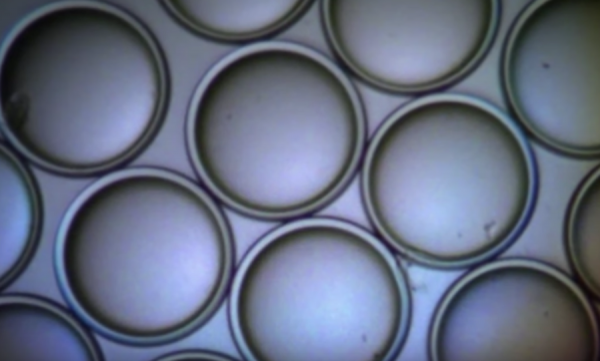By Vishal Goel, | March 15, 2017

Researchers at MIT have now devised tiny “microlenses” from complex liquid droplets comparable in size to the width of a human hair. (Youtube)
MIT researchers have created "microlenses" by using the natural magnifying ability of liquid droplets. The complex droplets, comparable in size to the width of a human hair, consist of an emulsion, one drop inside another drop, like an oil bead in a water drop.
Scientists were successfully able to precisely shape the curvature of the interface between the internal bead and the surrounding droplet using a combination of chemistry and light , similar to adjusting the focus on a microscope.
Like Us on Facebook
"Fluids are very versatile optically," says Mathias Kolle, the Brit and Alex d'Arbeloff Career Development Assistant Professor in the Department of Mechanical Engineering at MIT. He further added that they can create complex geometries that form lenses that can be tuned optically. "When you have a tunable microlens, you can dream up all sorts of applications," he said.
For instance, Kolle says, tunable microlenses could be used as liquid pixels in a three-dimensional display, directing light to precisely determined angles and projecting images that change depending on the observer's angle.
He also envisions pocket-sized microscopes that could take a sample of blood and pass it over an array of tiny droplets that would capture images from varying perspectives, which could be used to recover a three-dimensional image of individual blood cells.
The group's work builds on a research by Swager's team, which in 2015 reported a completely new way to create and reconfigure complex emulsions. Particularly, the team developed a simple technique to create and control the size and configuration of double emulsions, such as water that was suspended in oil and then suspended again in water. Kolle and his colleagues used the same technique to make their liquid lenses.
This research was supported, in part, by the Natural Sciences and Engineering Research Council of Canada, National Science Foundation and the Max Planck Society. The research has been published in the journal Nature Communications.
-
Use of Coronavirus Pandemic Drones Raises Privacy Concerns: Drones Spread Fear, Local Officials Say

-
Coronavirus Hampers The Delivery Of Lockheed Martin F-35 Stealth Fighters For 2020

-
Instagram Speeds Up Plans to Add Account Memorialization Feature Due to COVID-19 Deaths

-
NASA: Perseverance Plans to Bring 'Mars Rock' to Earth in 2031

-
600 Dead And 3,000 In The Hospital as Iranians Believed Drinking High-Concentrations of Alcohol Can Cure The Coronavirus

-
600 Dead And 3,000 In The Hospital as Iranians Believed Drinking High-Concentrations of Alcohol Can Cure The Coronavirus

-
COVID-19: Doctors, Nurses Use Virtual Reality to Learn New Skills in Treating Coronavirus Patients










